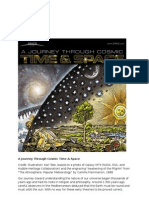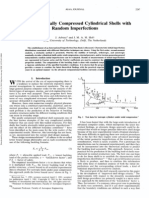0 ratings0% found this document useful (0 votes)
22 viewsFor Other Uses, See .: Star (Disambiguation)
For Other Uses, See .: Star (Disambiguation)
Uploaded by
Arjel JamiasA star is a massive, luminous sphere of plasma held together by gravity. Stars shine through nuclear fusion at their cores, and go through various stages of evolution over their lifetimes, eventually dying as remnants like white dwarfs or neutron stars. Ancient cultures observed stars and grouped them into constellations, while modern astronomy involves detailed study and cataloging of their properties and life cycles through observation and spectroscopy.
Copyright:
© All Rights Reserved
Available Formats
Download as DOCX, PDF, TXT or read online from Scribd
For Other Uses, See .: Star (Disambiguation)
For Other Uses, See .: Star (Disambiguation)
Uploaded by
Arjel Jamias0 ratings0% found this document useful (0 votes)
22 views5 pagesA star is a massive, luminous sphere of plasma held together by gravity. Stars shine through nuclear fusion at their cores, and go through various stages of evolution over their lifetimes, eventually dying as remnants like white dwarfs or neutron stars. Ancient cultures observed stars and grouped them into constellations, while modern astronomy involves detailed study and cataloging of their properties and life cycles through observation and spectroscopy.
Original Description:
13
Original Title
Star
Copyright
© © All Rights Reserved
Available Formats
DOCX, PDF, TXT or read online from Scribd
Share this document
Did you find this document useful?
Is this content inappropriate?
A star is a massive, luminous sphere of plasma held together by gravity. Stars shine through nuclear fusion at their cores, and go through various stages of evolution over their lifetimes, eventually dying as remnants like white dwarfs or neutron stars. Ancient cultures observed stars and grouped them into constellations, while modern astronomy involves detailed study and cataloging of their properties and life cycles through observation and spectroscopy.
Copyright:
© All Rights Reserved
Available Formats
Download as DOCX, PDF, TXT or read online from Scribd
Download as docx, pdf, or txt
0 ratings0% found this document useful (0 votes)
22 views5 pagesFor Other Uses, See .: Star (Disambiguation)
For Other Uses, See .: Star (Disambiguation)
Uploaded by
Arjel JamiasA star is a massive, luminous sphere of plasma held together by gravity. Stars shine through nuclear fusion at their cores, and go through various stages of evolution over their lifetimes, eventually dying as remnants like white dwarfs or neutron stars. Ancient cultures observed stars and grouped them into constellations, while modern astronomy involves detailed study and cataloging of their properties and life cycles through observation and spectroscopy.
Copyright:
© All Rights Reserved
Available Formats
Download as DOCX, PDF, TXT or read online from Scribd
Download as docx, pdf, or txt
You are on page 1of 5
Star
From Wikipedia, the free encyclopedia
For other uses, see Star (disambiguation).
A star-forming region in the Large Magellanic Cloud. NASA/ESA image
False-color imagery of the Sun, a G-type main-sequence star, the closest to Earth.
A star is a massive, luminous sphere of plasma held together by its own gravity. The nearest star
to Earth is the Sun, which is the source of most of the planet's energy. Some other stars are visible
from Earth during the night, appearing as a multitude of fixed luminous points due to their immense
distance. Historically, the most prominent stars were grouped into constellations and asterisms, and
the brightest stars gained proper names. Extensive catalogues of stars have been assembled by
astronomers, which provide standardized star designations.
For at least a portion of its life, a star shines due to thermonuclear fusion of hydrogen into helium in
its core, releasing energy that traverses the star's interior and then radiates into outer space. Once
the hydrogen in the core of a star is nearly exhausted, almost all naturally occurring elements
heavier than helium are created by stellar nucleosynthesis during the star's lifetime and, for some
stars, bysupernova nucleosynthesis when it explodes. Near the end of its life, a star can also
contain degenerate matter. Astronomers can determine the mass, age, metallicity (chemical
composition), and many other properties of a star by observing its motion through space,luminosity,
and spectrum respectively. The total mass of a star is the principal determinant of its evolution and
eventual fate. Other characteristics of a star, including diameter and temperature, change over its
life, while the star's environment affects its rotation and movement. A plot of the temperature of
many stars against their luminosities, known as a HertzsprungRussell diagram (HR diagram),
allows the age and evolutionary state of a star to be determined.
A star's life begins with the gravitational collapse of a gaseous nebula of material composed
primarily of hydrogen, along with helium and trace amounts of heavier elements. Once the stellar
core is sufficiently dense, hydrogen becomes steadily converted into helium through nuclear fusion,
releasing energy in the process.
[1]
The remainder of the star's interior carries energy away from the
core through a combination of radiative and convective processes. The star's internal pressure
prevents it from collapsing further under its own gravity. Once the hydrogen fuel at the core is
exhausted, a star with at least 0.4 times the mass of the Sun
[2]
expands to become a red giant, in
some cases fusing heavier elements at the core or in shells around the core. The star then evolves
into a degenerate form, recycling a portion of its matter into the interstellar environment, where it will
contribute to the formation of a new generation of stars with a higher proportion of heavy
elements.
[3]
Meanwhile, the core becomes a stellar remnant: a white dwarf, a neutron star, or (if it is
sufficiently massive) a black hole.
Binary and multi-star systems consist of two or more stars that are gravitationally bound, and
generally move around each other in stable orbits. When two such stars have a relatively close orbit,
their gravitational interaction can have a significant impact on their evolution.
[4]
Stars can form part of
a much larger gravitationally bound structure, such as astar cluster or a galaxy.
Contents
[hide]
1 Observation history
2 Designations
3 Units of measurement
4 Formation and evolution
o 4.1 Protostar formation
o 4.2 Main sequence
o 4.3 Post-main sequence
4.3.1 Massive stars
4.3.2 Collapse
5 Distribution
6 Characteristics
o 6.1 Age
o 6.2 Chemical composition
o 6.3 Diameter
o 6.4 Kinematics
o 6.5 Magnetic field
o 6.6 Mass
o 6.7 Rotation
o 6.8 Temperature
7 Radiation
o 7.1 Luminosity
o 7.2 Magnitude
8 Classification
9 Variable stars
10 Structure
11 Nuclear fusion reaction pathways
12 See also
13 References
14 Further reading
15 External links
Observation history
People have seen patterns in the stars since ancient times.
[5]
This 1690 depiction of the constellation of Leo, the lion,
is by Johannes Hevelius.
[6]
The constellation of Leo as it can be seen by the naked eye. Lines have been added.
Historically, stars have been important to civilizations throughout the world. They have been part
of religious practices and used forcelestial navigation and orientation. Many ancient astronomers
believed that stars were permanently affixed to a heavenly sphere, and that they were immutable. By
convention, astronomers grouped stars into constellations and used them to track the motions of
the planets and the inferred position of the Sun.
[5]
The motion of the Sun against the background
stars (and the horizon) was used to create calendars, which could be used to regulate agricultural
practices.
[7]
The Gregorian calendar, currently used nearly everywhere in the world, is a solar
calendar based on the angle of the Earth's rotational axis relative to its local star, the Sun.
The oldest accurately dated star chart appeared in ancient Egyptian astronomy in 1534
BC.
[8]
The earliest known star catalogues were compiled by the ancient Babylonian
astronomers of Mesopotamia in the late 2nd millennium BC, during the Kassite Period (ca. 1531
1155 BC).
[9]
The first star catalogue in Greek astronomy was created by Aristillus in approximately 300 BC, with
the help of Timocharis.
[10]
The star catalog of Hipparchus (2nd century BC) included 1020 stars and
was used to assemble Ptolemy's star catalogue.
[11]
Hipparchus is known for the discovery of the first
recorded nova (new star).
[12]
Many of the constellations and star names in use today derive from
Greek astronomy.
In spite of the apparent immutability of the heavens, Chinese astronomers were aware that new
stars could appear.
[13]
In 185 AD, they were the first to observe and write about a supernova, now
known as the SN 185.
[14]
The brightest stellar event in recorded history was theSN 1006 supernova,
which was observed in 1006 and written about by the Egyptian astronomer Ali ibn Ridwan and
several Chinese astronomers.
[15]
The SN 1054 supernova, which gave birth to the Crab Nebula, was
also observed by Chinese and Islamic astronomers.
[16][17][18]
Medieval Islamic astronomers gave Arabic names to many stars that are still used today, and they
invented numerous astronomical instruments that could compute the positions of the stars. They
built the first large observatory research institutes, mainly for the purpose of producing Zij star
catalogues.
[19]
Among these, the Book of Fixed Stars (964) was written by
the Persian astronomer Abd al-Rahman al-Sufi, who observed a number of stars, star
clusters (including the Omicron Velorum and Brocchi's Clusters) and galaxies (including
theAndromeda Galaxy).
[20]
According to A. Zahoor, in the 11th century, the
Persian polymath scholar Abu Rayhan Biruni described the Milky Way galaxy as a multitude of
fragments having the properties of nebulous stars, and also gave the latitudes of various stars during
a lunar eclipse in 1019.
[21]
According to Josep Puig, the Andalusian astronomer Ibn Bajjah proposed that the Milky Way was
made up of many stars which almost touched one another and appeared to be a continuous image
due to the effect of refraction from sublunary material, citing his observation of the conjunction of
Jupiter and Mars on 500 AH (1106/1107 AD) as evidence.
[22]
Early European astronomers such
as Tycho Braheidentified new stars in the night sky (later termed novae), suggesting that the
heavens were not immutable. In 1584 Giordano Brunosuggested that the stars were like the Sun,
and may have other planets, possibly even Earth-like, in orbit around them,
[23]
an idea that had been
suggested earlier by the ancient Greek philosophers, Democritus and Epicurus,
[24]
and by
medieval Islamic cosmologists
[25]
such as Fakhr al-Din al-Razi.
[26]
By the following century, the idea of
the stars being the same as the Sun was reaching a consensus among astronomers. To explain why
these stars exerted no net gravitational pull on the Solar System, Isaac Newton suggested that the
stars were equally distributed in every direction, an idea prompted by the theologian Richard
Bentley.
[27]
The Italian astronomer Geminiano Montanari recorded observing variations in luminosity of the
star Algol in 1667. Edmond Halley published the first measurements of the proper motion of a pair of
nearby "fixed" stars, demonstrating that they had changed positions from the time of the
ancient Greek astronomers Ptolemy and Hipparchus.
[23]
William Herschel was the first astronomer to attempt to determine the distribution of stars in the sky.
During the 1780s, he performed a series of gauges in 600 directions, and counted the stars
observed along each line of sight. From this he deduced that the number of stars steadily increased
toward one side of the sky, in the direction of the Milky Waycore. His son John Herschel repeated
this study in the southern hemisphere and found a corresponding increase in the same
direction.
[28]
In addition to his other accomplishments, William Herschel is also noted for his discovery
that some stars do not merely lie along the same line of sight, but are also physical companions that
form binary star systems.
The science of stellar spectroscopy was pioneered by Joseph von Fraunhofer and Angelo Secchi.
By comparing the spectra of stars such as Sirius to the Sun, they found differences in the strength
and number of their absorption linesthe dark lines in a stellar spectra due to the absorption of
specific frequencies by the atmosphere. In 1865 Secchi began classifying stars into spectral
types.
[29]
However, the modern version of the stellar classification scheme was developed by Annie J.
Cannon during the 1900s.
Alpha Centauri A and B over limb ofSaturn
The first direct measurement of the distance to a star (61 Cygni at 11.4 light-years) was made in
1838 by Friedrich Bessel using theparallax technique. Parallax measurements demonstrated the
vast separation of the stars in the heavens.
[23]
Observation of double stars gained increasing
importance during the 19th century. In 1834, Friedrich Bessel observed changes in the proper
motion of the star Sirius, and inferred a hidden companion. Edward Pickering discovered the
first spectroscopic binary in 1899 when he observed the periodic splitting of the spectral lines of the
star Mizar in a 104-day period. Detailed observations of many binary star systems were collected by
astronomers such as William Struve and S. W. Burnham, allowing the masses of stars to be
determined from computation of the orbital elements. The first solution to the problem of deriving an
orbit of binary stars from telescope observations was made by Felix Savary in 1827.
[30]
The twentieth
century saw increasingly rapid advances in the scientific study of stars. The photograph became a
valuable astronomical tool. Karl Schwarzschild discovered that the color of a star, and hence its
temperature, could be determined by comparing thevisual magnitude against the photographic
magnitude. The development of the photoelectric photometer allowed very precise measurements of
magnitude at multiple wavelength intervals. In 1921 Albert A. Michelson made the first
measurements of a stellar diameter using an interferometer on the Hooker telescope.
[31]
Important theoretical work on the physical structure of stars occurred during the first decades of the
twentieth century. In 1913, the Hertzsprung-Russell diagram was developed, propelling the
astrophysical study of stars. Successful models were developed to explain the interiors of stars and
stellar evolution. Cecilia Payne-Gaposchkin first proposed that stars were made primarily of
hydrogen and helium in her 1925 PhD thesis.
[32]
The spectra of stars were further understood through
advances in quantum physics. This allowed the chemical composition of the stellar atmosphere to be
determined.
[33]
With the exception of supernovae, individual stars have primarily been observed in our Local
Group of galaxies,
[34]
and especially in the visible part of the Milky Way (as demonstrated by the
detailed star catalogues available for our galaxy).
[35]
But some stars have been observed in the M100
galaxy of the Virgo Cluster, about 100 million light years from the Earth.
[36]
In the Local Supercluster it
is possible to see star clusters, and current telescopes could in principle observe faint individual
stars in the Local Cluster
[37]
(see Cepheids). However, outside the Local Supercluster of galaxies,
neither individual stars nor clusters of stars have been observed. The only exception is a faint image
of a large star cluster containing hundreds of thousands of stars located at a distance of one billion
light years
[38]
ten times further than the most distant star cluster previously observed.
You might also like
- Volare Questions - Radio Nav FinalDocument34 pagesVolare Questions - Radio Nav FinalCdr. PearlNo ratings yet
- The Earth and The UniverseDocument40 pagesThe Earth and The UniverseMay Lyn Rosal BerondoNo ratings yet
- StarDocument8 pagesStarXyreneAshleighNo ratings yet
- This Article Is About The Astronomical Object. For Other Uses, SeeDocument9 pagesThis Article Is About The Astronomical Object. For Other Uses, SeeyosephineikaaNo ratings yet
- StarDocument80 pagesStarAnonymous UFmvMAYRZNo ratings yet
- Star - WikipediaDocument191 pagesStar - WikipediaAnil KumarNo ratings yet
- Star - WikipediaDocument227 pagesStar - WikipediaSharlyn SefanieJamzelian A PedroNo ratings yet
- StarDocument33 pagesStardefiantnxds9No ratings yet
- Star - WikipediaDocument54 pagesStar - Wikipedialoinoto aye jakhaluNo ratings yet
- This Article Is About The Astronomical ObjectDocument20 pagesThis Article Is About The Astronomical ObjectV. RakeshNo ratings yet
- StarDocument4 pagesStarMario MorochoNo ratings yet
- NMP88Document2 pagesNMP88jafasoh293No ratings yet
- S TarDocument5 pagesS TarBenjie SoberanoNo ratings yet
- Planet: This Article Is About The Astronomical Object. For Other Uses, SeeDocument4 pagesPlanet: This Article Is About The Astronomical Object. For Other Uses, SeeArjel JamiasNo ratings yet
- Planet: Jump To Navigationjump To SearchDocument37 pagesPlanet: Jump To Navigationjump To SearchIorga IonutNo ratings yet
- Humans and ClimateDocument7 pagesHumans and Climateleonel ocanaNo ratings yet
- A Planet Is An Astronomical Body Orbiting A Star or Stellar Remnant That Is Massive Enough To Be Rounded by Its Own Gravity PDFDocument2 pagesA Planet Is An Astronomical Body Orbiting A Star or Stellar Remnant That Is Massive Enough To Be Rounded by Its Own Gravity PDFKwammy BrownNo ratings yet
- (Astēr Planētēs), Meaning "Wandering Star") IsDocument10 pages(Astēr Planētēs), Meaning "Wandering Star") Isaditya2053No ratings yet
- Planets 1Document27 pagesPlanets 1Michelle GutierrezNo ratings yet
- A Journey Through Space and TimeDocument22 pagesA Journey Through Space and TimeSeptian Hadi NugrahaNo ratings yet
- Earth and Life Science OutlineDocument6 pagesEarth and Life Science OutlineYveth CruzNo ratings yet
- Constellations: AlmagestDocument4 pagesConstellations: AlmagestAlemor AlviorNo ratings yet
- Chapter 7 The Origin of The Solar SystemDocument6 pagesChapter 7 The Origin of The Solar Systemapi-234121168No ratings yet
- PLANETDocument29 pagesPLANETAnime LoverNo ratings yet
- GalaxyDocument16 pagesGalaxyVijay Unique100% (1)
- The Story of AstronomyDocument46 pagesThe Story of AstronomyLinda De VriesNo ratings yet
- Stars 2Document1 pageStars 2ysabelle rocoNo ratings yet
- Physical Science, Q4 - Mod 1 - "Ancient and Modern Astronomy" (Grade 11) What I Need To KnowDocument11 pagesPhysical Science, Q4 - Mod 1 - "Ancient and Modern Astronomy" (Grade 11) What I Need To KnowManuelito Balacuit Pacatang Morre100% (2)
- Physical Science Reviewer 1 1Document6 pagesPhysical Science Reviewer 1 1JAMES GAMERNo ratings yet
- Physical Science Reviewer 1 1Document7 pagesPhysical Science Reviewer 1 1Mishella TotanesNo ratings yet
- Astronomy Reviewer A Brief History of AstronomyDocument6 pagesAstronomy Reviewer A Brief History of AstronomyJenie Rose C. PeningNo ratings yet
- GalaxiesDocument6 pagesGalaxiesShiela VinsonNo ratings yet
- MMP96Document3 pagesMMP96jafasoh293No ratings yet
- Galaxy: Amending Our Terms of Use: Please Comment On A Proposed Amendment Regarding Undisclosed Paid EditingDocument32 pagesGalaxy: Amending Our Terms of Use: Please Comment On A Proposed Amendment Regarding Undisclosed Paid EditingdivyashreebollamwarNo ratings yet
- Planet: A Is An A or That Is Massive Enough To Be by Its Own, Is Not Massive Enough To Cause, and Has ofDocument3 pagesPlanet: A Is An A or That Is Massive Enough To Be by Its Own, Is Not Massive Enough To Cause, and Has ofCFK TaborNo ratings yet
- Planets Pt.8Document3 pagesPlanets Pt.8jpbalganion.fo2No ratings yet
- PlanetDocument2 pagesPlanetsorrowdzordsssNo ratings yet
- The Universe and Solar System by Sura J. AmilbaharDocument45 pagesThe Universe and Solar System by Sura J. AmilbaharAmilbahar Sura100% (1)
- NMP90Document2 pagesNMP90jafasoh293No ratings yet
- I. Universe and The Solar SystemDocument3 pagesI. Universe and The Solar SystemJenalyn JavierNo ratings yet
- NatSci TAPOS NA!!!!!-Final TFDocument54 pagesNatSci TAPOS NA!!!!!-Final TFWendyMayVillapaNo ratings yet
- UntitledDocument32 pagesUntitledmarkism RNNo ratings yet
- Module 1Document7 pagesModule 1Emmarie LlantinoNo ratings yet
- Topic 3Document67 pagesTopic 3シKeylaNo ratings yet
- FORCE, MOTION a-WPS OfficeDocument14 pagesFORCE, MOTION a-WPS OfficenarzisabelledumalilisNo ratings yet
- Starrs 3Document2 pagesStarrs 3ysabelle rocoNo ratings yet
- 645a226fe4b0146031629fa6 OriginalDocument6 pages645a226fe4b0146031629fa6 OriginalMAHADEV BHAKTINo ratings yet
- History Babylon Greco-Roman Astronomy IndiaDocument2 pagesHistory Babylon Greco-Roman Astronomy IndiaRolly GabuyoNo ratings yet
- Formation of The Solar System FinalDocument77 pagesFormation of The Solar System FinalMaribel membradoNo ratings yet
- Meteoric Astronomy - A Treatise on Shooting-Stars, Fire-Balls, and AerolitesFrom EverandMeteoric Astronomy - A Treatise on Shooting-Stars, Fire-Balls, and AerolitesNo ratings yet
- MMP90Document3 pagesMMP90jafasoh293No ratings yet
- Universe NatureDocument8 pagesUniverse Naturebharat singhNo ratings yet
- History of EarthDocument5 pagesHistory of EarthJudy GuevarraNo ratings yet
- Importance of AstronomyDocument4 pagesImportance of AstronomyJaja CarlinaNo ratings yet
- The Birth of Modern Astronomy: Galileo'S Astronomical ObservationsDocument4 pagesThe Birth of Modern Astronomy: Galileo'S Astronomical ObservationsAaronNo ratings yet
- PlanetDocument23 pagesPlanetBijendra SharmaNo ratings yet
- The Story of Astronomy: From plotting the stars to pulsars and black holesFrom EverandThe Story of Astronomy: From plotting the stars to pulsars and black holesNo ratings yet
- Models of The UniverseDocument11 pagesModels of The UniverseKing TanNo ratings yet
- The UniverseDocument5 pagesThe UniverseAn MaNo ratings yet
- Physicalscience - Q4 Lesson1 - AstronomyDocument59 pagesPhysicalscience - Q4 Lesson1 - AstronomyAljabier RellonNo ratings yet
- Fight SongDocument2 pagesFight SongArjel JamiasNo ratings yet
- Fight SongDocument1 pageFight SongArjel JamiasNo ratings yet
- Session 1 - His Work / Our Work: The Overall Goal / PictureDocument5 pagesSession 1 - His Work / Our Work: The Overall Goal / PictureArjel JamiasNo ratings yet
- Intro: Every Joint Supplies, According To The Effective Working by Which Every Part Does Its Share, CausesDocument2 pagesIntro: Every Joint Supplies, According To The Effective Working by Which Every Part Does Its Share, CausesArjel JamiasNo ratings yet
- "Teaching Them To - Obey!" "Knowledge Puffs Up": For The Work of Ministry, For The Edifying of The Body of ChristDocument3 pages"Teaching Them To - Obey!" "Knowledge Puffs Up": For The Work of Ministry, For The Edifying of The Body of ChristArjel JamiasNo ratings yet
- Sportaccord Association Football Athletics Cycling Tennis Equestrian SportsDocument1 pageSportaccord Association Football Athletics Cycling Tennis Equestrian SportsArjel JamiasNo ratings yet
- For Other Types of Power, SeeDocument1 pageFor Other Types of Power, SeeArjel JamiasNo ratings yet
- 13 Million Pseudoscience Numerology Greek MathematicsDocument1 page13 Million Pseudoscience Numerology Greek MathematicsArjel JamiasNo ratings yet
- Solicitation Letter Church CampDocument2 pagesSolicitation Letter Church CampArjel Jamias83% (6)
- Variations: VoicesDocument1 pageVariations: VoicesArjel JamiasNo ratings yet
- Lærɪŋks/ Organ Neck Tetrapods Trachea Vocal Folds Pitch Phonation Pharynx Esophagus Ancient GreekDocument1 pageLærɪŋks/ Organ Neck Tetrapods Trachea Vocal Folds Pitch Phonation Pharynx Esophagus Ancient GreekArjel JamiasNo ratings yet
- Music Is An Art Form And: MousikeDocument1 pageMusic Is An Art Form And: MousikeArjel JamiasNo ratings yet
- Anthropomorphic Koala TheaterDocument1 pageAnthropomorphic Koala TheaterArjel JamiasNo ratings yet
- Experiment 9 PDFDocument3 pagesExperiment 9 PDFdarshanNo ratings yet
- "Quantum Physics" - S. GasiorowiczDocument522 pages"Quantum Physics" - S. Gasiorowicz11111__11__1111100% (3)
- Govt - Degree College, Mahabubabad:: Department of Physics Electromagnetism:: Question BankDocument1 pageGovt - Degree College, Mahabubabad:: Department of Physics Electromagnetism:: Question BankReddyvari VenugopalNo ratings yet
- Force and MotionDocument7 pagesForce and MotionEreeNo ratings yet
- MTN User ManualDocument26 pagesMTN User ManualScarlat AlvesNo ratings yet
- Lect 6 Steam EngineDocument23 pagesLect 6 Steam EnginemechNo ratings yet
- ME2030 - 20160406 - Plastic Shaping (Groover Slides Partial)Document43 pagesME2030 - 20160406 - Plastic Shaping (Groover Slides Partial)Vamshi KrishnaNo ratings yet
- Camera CB24 FileDocument2 pagesCamera CB24 FileagarcosNo ratings yet
- CSS CatalogueDocument8 pagesCSS CatalogueT sureshNo ratings yet
- Math7 Curriculum MapDocument11 pagesMath7 Curriculum MapRica CareNo ratings yet
- Formula Sheet - PCMDocument7 pagesFormula Sheet - PCMRonit MalhotraNo ratings yet
- Elastic Stability of Thin - Walled Cylindrical and Conical Shells Under Axial CompressionDocument10 pagesElastic Stability of Thin - Walled Cylindrical and Conical Shells Under Axial CompressionChandra PrakashNo ratings yet
- Cobalt in GlassDocument11 pagesCobalt in GlassNUR HIDAYAHNo ratings yet
- Devotion and MindDocument426 pagesDevotion and Mindnavin jollyNo ratings yet
- Spray Drying Thesis 2014Document394 pagesSpray Drying Thesis 2014Emily PresswoodNo ratings yet
- Gupta - Gupta Civil Complete SolutionDocument5,933 pagesGupta - Gupta Civil Complete SolutionSabahat MehboobNo ratings yet
- BMM3643 Manufacturing Process: 8.0 Materials Removal PROCESSES: MachiningDocument16 pagesBMM3643 Manufacturing Process: 8.0 Materials Removal PROCESSES: MachiningRima ChinnasamyNo ratings yet
- Topic15 Properties of DTFSDocument7 pagesTopic15 Properties of DTFSyadavanshikarajNo ratings yet
- LT LG400 13 Inspection Maintenance ProceduresDocument6 pagesLT LG400 13 Inspection Maintenance ProceduresTerminal TruckNo ratings yet
- Gland Seal Water SPOOL 1.5": AREA: 3510Document12 pagesGland Seal Water SPOOL 1.5": AREA: 3510JHONATAN RODRIGUEZ VENTONo ratings yet
- Electronic Materials: Prof. Vishal S. VadgamaDocument125 pagesElectronic Materials: Prof. Vishal S. VadgamaRaj PatrlNo ratings yet
- Aquinas and Quantum TheoryDocument29 pagesAquinas and Quantum TheoryMiguel MonteiroNo ratings yet
- Hydrodynamic Simulation of Horizontal Slurry Pipeline Flow Using ANSYS-CFXDocument39 pagesHydrodynamic Simulation of Horizontal Slurry Pipeline Flow Using ANSYS-CFXAvinash VasudeoNo ratings yet
- EMLab II Manual - 19022019 - FinalDocument40 pagesEMLab II Manual - 19022019 - FinalNikitha E KattimaniNo ratings yet
- NCERT Lab Manual - Verifying (A+b+c) 2Document2 pagesNCERT Lab Manual - Verifying (A+b+c) 2Pranav Reddy SathiNo ratings yet
- Vacuum Pump: Oil-Free Pump With Constant Suction Rate, Robust, Requires Little MaintenanceDocument3 pagesVacuum Pump: Oil-Free Pump With Constant Suction Rate, Robust, Requires Little MaintenanceselvaortonNo ratings yet
- Ground Water Engineering - CV0612 - Unit 3Document100 pagesGround Water Engineering - CV0612 - Unit 3Paulo SantosNo ratings yet
- AISC - Inspection of Welded and Bolted JointsDocument26 pagesAISC - Inspection of Welded and Bolted JointsAdisak AumpiemNo ratings yet
- Tiểu luận NLM (Chỉ tham khảo)Document41 pagesTiểu luận NLM (Chỉ tham khảo)duy8211122003No ratings yet






































































































